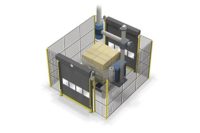In response to incredible technological strides in manufacturing processes in the food industry, industrial safety standards are being updated to keep pace.  However, plant managers who haven’t been keeping up with these developments might find what they did in years past is no longer adequate. That’s why instead of risking costly fines and employee injuries, many companies are implementing safer practices before regulatory bodies mandate them.
However, plant managers who haven’t been keeping up with these developments might find what they did in years past is no longer adequate. That’s why instead of risking costly fines and employee injuries, many companies are implementing safer practices before regulatory bodies mandate them.
How stretch wrap safety is lagging behind
While regulatory changes have been adopted to keep up with the pace of some technological advances, one area of plant operation in which new regulations have not kept pace is with stretch wrap machines. As ubiquitous as they are at food processing and storage facilities, there still aren’t specific OSHA guidelines regarding proper guarding of stretch wrap machinery.
Currently, these machines default to the general requirements for all machines per OSHA 29 CFR 1910.212 (a) (3) (ii), stating that "the point of operation of machines whose operation exposes an employee to injury SHALL BE GUARDED." The code goes on to state that “in the absence of applicable specific standards, the machine shall be so designed and constructed to prevent the operator from having any part of [his/her] body in the danger zone during the operating cycle.” Fortunately, proper guarding devices such as fixed fencing and automated barrier doors can isolate stretch wrap machine operation.
Additionally, every operation should at least uphold the OSHA general requirements of all machines. As a basic rule, companies should ensure the safety of their employees. The OSHA general duties clause stipulates the following:
(a) Each employer:
(1) Shall furnish to each of his employees a place of employment, which is free from recognized hazards that are causing or are likely to cause death or serious physical harm; and…
(2) Shall comply with occupational safety and health standards promulgated under this act.
(b) Each employee shall comply with occupational safety and health standards and all rules, regulations and orders issued pursuant to this act, which are applicable to his own actions and conduct.
As with most other industrial processes, what began as a manual operation (the arduous task of bending, pulling and moving stretch wrap around a pallet) is now commonly automated. Most workers are happy to not “stoop and circle” a pallet of refrigerated or frozen foods, but rather push a button and allow the machine to take over the task.
However, this particular aspect of plant operation has long been overlooked as a hazard. With suppliers adding more automated functions to their floors (including automated conveyors, AGVs and AS/RS systems), it’s critical that safety methodology is similar to that of other automated or robotic processes and is compliant with current standards.
Safety options for points-of-interaction
Certainly, presence-sensing devices such as light curtains and laser scanners are potential solutions for point-of-interaction safety, whether it’s on the assembly line or at a stretch wrap machine. Automated barrier doors may provide an even better option, as they have many of the same benefits as presence sensors, but with several additional advantages.
Most notably, automated barrier doors provide a physical barrier that can protect an employee and contain the process, while at the same time restricting access to dangerous machine movement. This is particularly important for processes such as stretch wrapping, in which inertia keeps machinery in motion even after it has been shut down. It also prevents workers from getting close to the pallet, where stretch-wrapped products such as frozen foods might form slick areas on the ground due to condensation. Additionally, an automated barrier door can be located closer to the process, allowing for a much smaller footprint in the facility.
The most advanced roll-up automated barrier doors offer high-speed, high-cycle technology, as well as PLe safety-rated, non-contact interlock switches and controls. Most automated doors function from the top down, but some have been designed to operate from the ground up. This allows machine operators to easily interact with the process utilizing overhead cranes to load and unload large, heavy pallets. They are also a great option for interaction points that have a very limited space.
The future of stretch wrap safety
With new industrial safety regulations taking effect, it is important that managers of food processing and storage facilities keep up on the latest safety technologies to match the right product to the right process, taking not only potential machine hazards into consideration, but also the task being performed.
It is also important that these managers look past the lack of specific stretch wrap safety regulations when making equipment decisions. Instead, consider the broader context of OSHA language and guard “the point of operation of machines, whose operation exposes an employee to injury.” Clearly, automated and/or robotic stretch wrap operations fall into this category.
Given the recent advances in their design and technology, automated barrier doors can be an excellent option to guard these machines and protect operators, ultimately increasing productivity and the level of safety for years to come.



